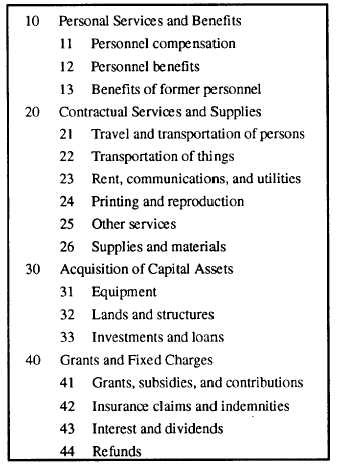| |
As shown in figure 2-3, there are four major
categories of object classes: (1) personal services and
benefits, (2) contractual services and supplies,
(3) acquisition of capital assets, and (4) grants and fixed
charges.
The Office of Management and Budget (OMB)
directs the use of these classifications whenever the
object class is required in the submitting of budget
requests and reporting of data. The object class will
appear as part of the accounting code required for
obligations, costs, or disbursements.
BUREAU CONTROL NUMBER
The fourth element in the accounting classification
code is the bureau control number. As shown in figure
2-2 (number 4), the bureau control number consists of
five digits and represents the allotment authorization
number. All funds within an appropriation account to
be used for commitments, obligations, and expenditures
are issued through allotments. An allotment is a
subdivision of the appropriation that provides the
funding authority for the accomplishment of a specific
function or mission. The first two digits of the bureau
Figure 2-3.-Major categories of object classes.
control number designate the budget project; the next
three digits constitute the serial number assigned to the
allotment.
In some cases, funds are not provided by an
allotment. In these cases, the bureau control number is
coded to identify other necessary accounting
information.
SUBALLOTMENT
The suballotment is the fifth element of the
accounting classification code. (Refer to number 5 in
figure 2-2.) It further subdivides the allotment. The
suballotment consists of one character that can be either
alpha or numeric, as determined by the holder of the
allotment.
AUTHORIZATION ACCOUNTING
ACTIVITY
As shown in figure 2-2, the authorization
accounting activity is the sixth element of the
accounting classification code. It is composed of six
digits and identities the activity designated to perform
allotment accounting and other accounting
assignments. For this element, the unit identification
code (UIC) of the designated accounting activity is
used. Since UICs only contain five digits, a zero prefix
is added to make six digits. Notice that in the
accounting data presented in figure 2-2, the
authorization accounting activity is not required. In
cases such as these, six zeroes are used to fill the field.
TRANSACTION TYPE
The seventh element represents the transaction
type. Because most Navy accounting transactions are
performed by machine, use of the two-digit
alphanumeric transaction code allows for machine
identification of the following categories:
1.
2.
3.
4.
5.
6.
7.
In
Stores account purchases
Plant property account purchases
Other special suspense-type accounts
Formal and other special obligation accounting
Successor appropriations
Register and listing identification
Other transactions of special interest
some cases, the functional account number
(FAN) may serve the same purpose as the transaction
2-5
|

